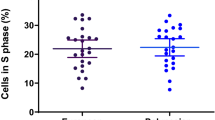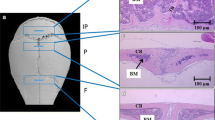Abstract
Objectives
The purpose of this study is to investigate the differences in gene expression between the human mandibular and iliac bone-derived cells (BCs) for better understanding of the site-specific characteristics of bones.
Methods
Primary cells were obtained from mandibular and iliac bones from six healthy, elderly donors. To investigate site-specific differences, gene expression profile of mandibular and iliac BC from the same donors were compared via cDNA microarray analysis.
Results
A comparison of the gene expression profiles revealed that 82 genes were significantly upregulated and 66 genes were downregulated with 1.5 fold or greater in mandibular versus iliac BCs. The most significantly differentially regulated genes were associated with skeletal system development or morphogenesis (SIX1, MSX1, MSX2, HAND2, PRRX1, OSR2, HOX gene family, PITX2). Especially, upregulated genes in mandibular BC were related with tooth morphogenesis, originated from the ectomesenchyme. Microarray analysis revealed that Msx1 was 2.03-fold and Msx2 was 1.99-fold upregulated in mandibular versus iliac BCs (both p < 0.01). Furthermore, in mandibular BCs, all members of the HOX gene family that were analyzed were downregulated (p < 0.01) and osteopontin was also downregulated by 2.84-fold (p < 0.01).
Conclusions
Site-specific differences between jaw and long bones can be explained by the differences in gene expression patterns. Our results suggest that bone cell-derived cells maintain the genetic characteristics of their embryological origin.
Clinical relevance
This study revealed fundamental differences in gene expression between the mandibular and iliac bone in humans. These differences could be important for understanding jaw bone-specific development of bisphosphonate-related osteonecrosis of the jaw.




Similar content being viewed by others
References
Jackson IT, Helden G, Marx R (1986) Skull bone grafts in maxillofacial and craniofacial surgery. J Oral Maxillofac Surg 44(12):949–955
Koole R, Bosker H, van der Dussen FN (1989) Late secondary autogenous bone grafting in cleft patients comparing mandibular (ectomesenchymal) and iliac crest (mesenchymal) grafts. J Craniomaxillofac Surg 17(Suppl 1):28–30
Crespi R, Vinci R, Cappare P, Gherlone E, Romanos GE (2007) Calvarial versus iliac crest for autologous bone graft material for a sinus lift procedure: a histomorphometric study. Int J Oral Maxillofac Implants 22(4):527–532
Chai Y, Maxson RE Jr (2006) Recent advances in craniofacial morphogenesis. Dev Dyn 235(9):2353–2375
Helms JA, Schneider RA (2003) Cranial skeletal biology. Nature 423(6937):326–331
Kasperk C, Helmboldt A, Borcsok I, Heuthe S, Cloos O, Niethard F, Ziegler R (1997) Skeletal site-dependent expression of the androgen receptor in human osteoblastic cell populations. Calcif Tissue Int 61(6):464–473
Akintoye SO, Lam T, Shi S, Brahim J, Collins MT, Robey PG (2006) Skeletal site-specific characterization of orofacial and iliac crest human bone marrow stromal cells in same individuals. Bone 38(6):758–768
Matsubara T, Suardita K, Ishii M, Sugiyama M, Igarashi A, Oda R, Nishimura M, Saito M, Nakagawa K, Yamanaka K et al (2005) Alveolar bone marrow as a cell source for regenerative medicine: differences between alveolar and iliac bone marrow stromal cells. J Bone Miner Res 20(3):399–409
Akintoye SO, Giavis P, Stefanik D, Levin L, Mante FK (2008) Comparative osteogenesis of maxilla and iliac crest human bone marrow stromal cells attached to oxidized titanium: a pilot study. Clin Oral Implants Res 19(11):1197–1201
Aghaloo TL, Chaichanasakul T, Bezouglaia O, Kang B, Franco R, Dry SM, Atti E, Tetradis S (2010) Osteogenic potential of mandibular vs. long-bone marrow stromal cells. J Dent Res 89(11):1293–1298
Kingsmill VJ, McKay IJ, Ryan P, Ogden MR, Rawlinson SC (2013) Gene expression profiles of mandible reveal features of both calvarial and ulnar bones in the adult rat. J Dent 41(3):258–264
Payer M, Lohberger B, Stadelmeyer E, Bartmann C, Windhager R, Jakse N (2010) Behaviour of multipotent maxillary bone-derived cells on beta-tricalcium phosphate and highly porous bovine bone mineral. Clin Oral Implants Res 21(7):699–708
Nishimura M, Takase K, Suehiro F, Murata H (2012) Candidates cell sources to regenerate alveolar bone from oral tissue. Int J Dent 2012:857192
Kim KM, Lim J, Choi YA, Kim JY, Shin HI, Park EK (2012) Gene expression profiling of oral epithelium during tooth development. Arch Oral Biol 57(8):1100–1107
de Souza Faloni AP, Schoenmaker T, Azari A, Katchburian E, Cerri PS, de Vries TJ, Everts V (2011) Jaw and long bone marrows have a different osteoclastogenic potential. Calcif Tissue Int 88(1):63–74
Jiang SY, Shu R, Xie YF, Zhang SY (2010) Age-related changes in biological characteristics of human alveolar osteoblasts. Cell Prolif 43(5):464–470
Perinpanayagam H, Martin T, Mithal V, Dahman M, Marzec N, Lampasso J, Dziak R (2006) Alveolar bone osteoblast differentiation and Runx2/Cbfa1 expression. Arch Oral Biol 51(5):406–415
Kasperk C, Wergedal J, Strong D, Farley J, Wangerin K, Gropp H, Ziegler R, Baylink DJ (1995) Human bone cell phenotypes differ depending on their skeletal site of origin. J Clin Endocrinol Metab 80(8):2511–2517
Alappat S, Zhang ZY, Chen YP (2003) Msx homeobox gene family and craniofacial development. Cell Res 13(6):429–442
Mina M, Gluhak J, Upholt WB, Kollar EJ, Rogers B (1995) Experimental analysis of Msx-1 and Msx-2 gene expression during chick mandibular morphogenesis. Dev Dyn 202(2):195–214
Berdal A, Molla M, Hotton D, Aioub M, Lezot F, Nefussi JR, Goubin G (2009) Differential impact of MSX1 and MSX2 homeogenes on mouse maxillofacial skeleton. Cells Tissues Organs 189(1–4):126–132
Ishii M, Han J, Yen HY, Sucov HM, Chai Y, Maxson RE Jr (2005) Combined deficiencies of Msx1 and Msx2 cause impaired patterning and survival of the cranial neural crest. Development 132(22):4937–4950
Satokata I, Maas R (1994) Msx1 deficient mice exhibit cleft palate and abnormalities of craniofacial and tooth development. Nat Genet 6(4):348–356
Satokata I, Ma L, Ohshima H, Bei M, Woo I, Nishizawa K, Maeda T, Takano Y, Uchiyama M, Heaney S et al (2000) Msx2 deficiency in mice causes pleiotropic defects in bone growth and ectodermal organ formation. Nat Genet 24(4):391–395
Roybal PG, Wu NL, Sun J, Ting MC, Schafer CA, Maxson RE (2010) Inactivation of Msx1 and Msx2 in neural crest reveals an unexpected role in suppressing heterotopic bone formation in the head. Dev Biol 343(1–2):28–39
Orestes-Cardoso SM, Nefussi JR, Hotton D, Mesbah M, Orestes-Cardoso MD, Robert B, Berdal A (2001) Postnatal Msx1 expression pattern in craniofacial, axial, and appendicular skeleton of transgenic mice from the first week until the second year. Dev Dyn 221(1):1–13
Dodig M, Kronenberg M, Bedalov A, Kream B, Gronowicz G, Clark S, Mack K, Liu Y, Maxon R, Pan Z (1996) Identification of a TAAT-containing motif required for high level expression of the COL1A1 promoter in differentiated osteoblasts of transgenic mice. J Biol Chem 271:16422–16429
Wehrhan F, Hyckel P, Amann K, Ries J, Stockmann P, Schlegel K, Neukam F, Nkenke E (2011) Msx-1 is suppressed in bisphosphonate-exposed jaw bone analysis of bone turnover-related cell signalling after bisphosphonate treatment. Oral Dis 17(4):433–442
Nonomura K, Takahashi M, Wakamatsu Y, Takano-Yamamoto T, Osumi N (2010) Dynamic expression of Six family genes in the dental mesenchyme and the epithelial ameloblast stem/progenitor cells during murine tooth development. J Anat 216(1):80–91
Shin JO, Kim EJ, Cho KW, Nakagawa E, Kwon HJ, Cho SW, Jung HS (2012) BMP4 signaling mediates Zeb family in developing mouse tooth. Histochem Cell Biol 137(6):791–800
Leucht P, Kim JB, Amasha R, James AW, Girod S, Helms JA (2008) Embryonic origin and Hox status determine progenitor cell fate during adult bone regeneration. Development 135(17):2845–2854
Ackema KB, Charite J (2008) Mesenchymal stem cells from different organs are characterized by distinct topographic Hox codes. Stem Cells Dev 17(5):979–991
Wang KC, Helms JA, Chang HY (2009) Regeneration, repair and remembering identity: the three Rs of Hox gene expression. Trends Cell Biol 19(6):268–275
Kachgal S, Mace KA, Boudreau NJ (2012) The dual roles of homeobox genes in vascularization and wound healing. Cell Adhes Migr 6(6):457–470
Gravallese EM (2003) Osteopontin: a bridge between bone and the immune system. J Clin Invest 112(2):147–149
Giachelli CM, Steitz S (2000) Osteopontin: a versatile regulator of inflammation and biomineralization. Matrix Biol 19(7):615–622
McKee MD, Nanci A (1996) Osteopontin: an interfacial extracellular matrix protein in mineralized tissues. Connect Tissue Res 35(1–4):197–205
Hoefert S, Schmitz I, Tannapfel A, Eufinger H (2010) Importance of microcracks in etiology of bisphosphonate-related osteonecrosis of the jaw: a possible pathogenetic model of symptomatic and non-symptomatic osteonecrosis of the jaw based on scanning electron microscopy findings. Clin Oral Investig 14(3):271–284
Dobreva G, Chahrour M, Dautzenberg M, Chirivella L, Kanzler B, Fariñas I, Karsenty G, Grosschedl R (2006) SATB2 is a multifunctional determinant of craniofacial patterning and osteoblast differentiation. Cell 125(5):971–986
Hassan MQ, Tare R, Lee SH, Mandeville M, Weiner B, Montecino M, van Wijnen AJ, Stein JL, Stein GS, Lian JB (2007) HOXA10 controls osteoblastogenesis by directly activating bone regulatory and phenotypic genes. Mol Cell Biol 27(9):3337–3352
Picchi J, Trombi L, Spugnesi L, Barachini S, Maroni G, Brodano GB, Boriani S, Valtieri M, Petrini M, Magli MC (2013) HOX and TALE signatures specify human stromal stem cell populations from different sources. J Cell Physiol 228(4):879–889
Hassan MQ, Saini S, Gordon JA, van Wijnen AJ, Montecino M, Stein JL, Stein GS, Lian JB (2009) Molecular switches involving homeodomain proteins, HOXA10 and RUNX2 regulate osteoblastogenesis. Cells Tissues Organs 189(1–4):122–125
Acknowledgments
This research was supported by Basic Science Research Program through the National Research Foundation of Korea (NRF) funded by the Ministry of Education, Science and Technology (NRF 2010-0011-445).
Conflict of interest
The authors declare that they have no conflict of interest.
Author information
Authors and Affiliations
Corresponding author
Additional information
Jung-Tae Lee and So-Young Choi contributed equally to this paper.
Electronic supplementary material
Below is the link to the electronic supplementary material.
Supplementary data Table 1
(DOCX 13 kb)
Rights and permissions
About this article
Cite this article
Lee, JT., Choi, SY., Kim, HL. et al. Comparison of gene expression between mandibular and iliac bone-derived cells. Clin Oral Invest 19, 1223–1233 (2015). https://doi.org/10.1007/s00784-014-1353-8
Received:
Accepted:
Published:
Issue Date:
DOI: https://doi.org/10.1007/s00784-014-1353-8




